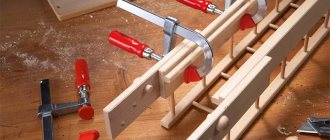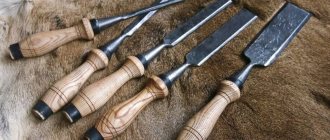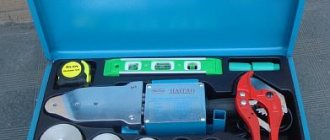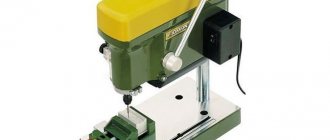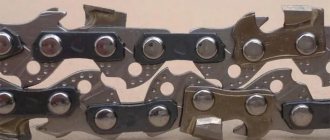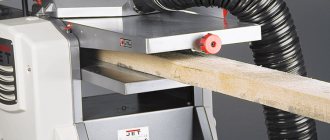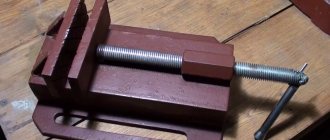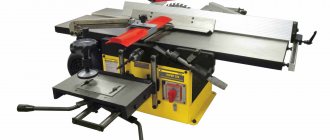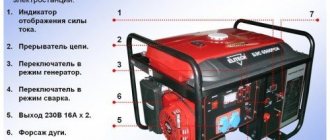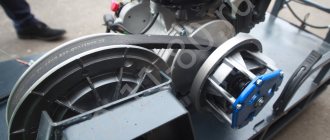Classification of gas regulators
Before using a pressure reducer, you should familiarize yourself with its types and the main parameters by which these devices are classified.
Principle of operation
According to the principle of operation, gas appliances are of direct and reverse type.
In direct-type gearboxes, the gas passing through the fitting acts on the valve using a spring, pressing it to the seat, thereby blocking high-pressure gas from entering the chamber. After pressing the valve membrane away from the seat, the pressure gradually decreases to the operating level of the gas appliance.
The principle of operation of the reverse type device is based on compressing the valve and blocking further gas supply. Using a special adjustable screw, the pressure spring is compressed, the membrane is bent, and the transfer disk acts on the return spring. The service valve is raised and gas flow to the equipment is resumed.
When the pressure of the system (cylinder, reducer, working equipment) increases in the reducer with the help of a spring, the membrane is straightened. The transfer disk, moving down, acts on the return spring and moves the valve towards the seat.
It should be noted that household reducers for reverse-action gas cylinders are safer.
Installation features
Based on positioning and installation features, devices are divided into ramp, network and balloon.
Ramp gas regulators are necessary to reduce and stabilize the gas pressure level supplied by one source. The devices tend to reduce the operating pressure of gas supplied from a central pipeline or a number of sources. Used for large volumes of welding work. Network stabilizers maintain the low pressure value of the gas supplied from the distribution manifold.
General rules for choosing a balloon reducer
Stable operation of the gas system depends on the quality and compatibility of all its components. When choosing a gearbox, it is necessary to take into account the compliance of its parameters with the needs of the devices connected through it.
Area of application of devices
For a gearbox, the following indicators are considered as the main characteristics:
- the type of gas that passes through the device;
- method of connection to the system;
- output pressure range;
- maximum performance;
- Operating temperature range.
Cylinders with reducers can be installed inside or outside the house.
The room in which the equipment is installed is subject to increased requirements for air exchange with the ability to quickly ventilate in the event of an emergency. The outdoor option saves space inside the building and is safer in case of flammable gas leaks.
The pressure reducing device is designed to reduce the pressure of the gas pumped into the cylinder to the operating values necessary for the normal functioning of gas equipment
Based on the type of gas passed through, reducers are divided into the following types, each of which is painted in a specific color for additional identification:
- acetylene - white;
- hydrogen - dark green;
- oxygen - blue;
- propane-butane - red;
- methane - red.
The color marking of gearboxes manufactured outside of Russia may differ.
The reducer, designed for a cylinder with a propane-butane mixture, is painted red. Devices designed for other gases cannot be used for liquefied hydrocarbons.
The characteristics of the purchased reducer must correspond to the parameters and type of gas cylinder and device with which it will be installed. Correct calibration of the output gas flow power is also important.
If the pressure value goes beyond the permissible range, the automation of a modern gas appliance will turn it off. If it is not equipped with such protection, then an emergency situation may arise.
Gearboxes, as potentially dangerous equipment, are subject to mandatory certification. If you have doubts about the factory origin of the purchased device, you must request a certificate of conformity.
System connection standards
To connect the reducer to a gas cylinder or to a supply line, 3 standards of threaded connections are usually used:
- W 21.8 x 1/14 - cylindrical thread standard DIN 477/T1, in Russia the abbreviation SP 21.8 is often used for it;
- G – cylindrical pipe thread, where the number after the letter indicates the nominal diameter in inches;
- M – metric thread, where the first number after the letter indicates the nominal diameter, and the second – the thread pitch in millimeters.
The symbols "LH" indicate that a left-hand thread is used.
Different types of gas cylinders use different standards for threaded connections. This fact must be taken into account when purchasing a gearbox (+)
Some simple devices only have one connection option. Thus, the popular Type 724B gearbox from Italy is equipped with a left-hand input thread W 21.8 x 1/14 for a standard metal cylinder. At the outlet there is a right-hand half-inch internal thread for connecting a bellows liner without any adapters.
A more complex device Type 733 with a pressure regulation function from the same manufacturer already has 6 inlet thread options: for metal and composite cylinders, for a gas tank multi-valve and 3 more connections. This model also has 3 output thread options.
If the inlet or outlet threads of the reducer do not correspond to the valve of the cylinder or liner, then use special adapters. However, the number of such connections must be minimized as they increase the risk of leakage. With standard gas equipment, it is not difficult to find a reducer with a suitable connection format.
Installation and startup procedure
First of all, the hoses of the gas supply system are installed without connecting it to the cylinder. Then the reducer nut is installed on the cylinder valve and after that the hoses are connected to it.
During this operation, the taps of the gas-consuming appliance, gas water heater, floor-standing gas boiler, stove, must be in the “closed” position. Before attaching the gearbox, to loosen the spring, you must turn out the adjusting screw until it stops.
The type of adjusting screw in the form of a valve is more convenient than a device that needs to be tightened with a screwdriver. However, it is necessary to limit children's access to such a device.
If you use an ordinary flexible hose, then to simplify the procedure, the reducer fitting can be moistened with water. This connection must be secured with a screw clamp. Bellows hoses are connected using a threaded adapter, which is screwed in instead of a fitting.
After installing the system, it is necessary to check for gas leakage with the devices not working. To do this, you need to tighten the gas flow valve (if there is one) and unscrew the adjusting screw to loosen the spring as much as possible.
If, after establishing the pressure difference, the pressure gauge needle shows a gradual increase in pressure, then the reducer cannot be used.
After assembling the entire system, it is necessary to ensure the flow of gas from the cylinder to the reducer and by rotating the adjusting screw to set the required outlet pressure. Then you need to coat the connections from the cylinder to the consuming device with a soapy solution to check them for gas leaks.
If the consuming device is a gas stove, then it is necessary to light the burners sequentially. If the flame on each of the burners is not blue, then you need to reduce the pressure on the reducer.
An orange or yellow burner flame indicates incomplete combustion of the fuel. This leads to significant emissions of carbon monoxide, which can be dangerous when using the stove for a long time
When checking the functionality of the burners at minimum heat, there may be a problem with their attenuation. To solve this, you need to either slightly increase the output pressure using the regulator on the gas cylinder reducer, or change the position of the flow screw on the stove itself.
If the problems described above are not typical for all burners, then the jets on the problematic parts of the stove need to be cleaned or replaced. If a gas leak occurs during system startup, the shut-off valve must be completely closed. Then you need to ventilate the room and begin troubleshooting.
Required pressure and volume
The throughput of the reducer must ensure the operation of all devices connected to the system at maximum gas consumption. Some of the problem in determining the required parameters is the use of different units of measurement.
There are two pressure units for gas appliances: pascals (Pa) and bars (br). For a reducer, the inlet pressure is determined in megapascals (1 MPa = 106 Pa) or bars, and the outlet pressure in pascals or millibars (1 mbr = 10-3 br). The conversion of pressure values between these units of measurement is carried out using the formula:
1 br = 105 Pa
The volume of gas passed through the reducer and consumed by the devices can also be represented by two quantities: kilograms and cubic meters.
The input and output pressure parameters of most Russian devices are indicated in pascals. On foreign devices, as a rule, pressure is indicated in bars
The indicators can be correlated using data on the density of the main bottled gases (kg/m3) at a temperature of 190C and standard atmospheric pressure:
- nitrogen: 1.17;
- argon: 1.67;
- acetylene: 1.10;
- butane: 2.41;
- hydrogen: 0.08;
- helium: 0.17;
- oxygen: 1.34;
- propane: 1.88;
- carbon dioxide: 1.85.
When recalculating indicators for household stoves, a problem may arise related to the proportion of propane and butane in gas cylinders. Their percentage ratio for different climatic regions is regulated by GOST 20448-90.
The density of the gas mixture depends on its percentage composition. For example, with a stated ratio of 60% propane and 40% butane, the gas density can be calculated as follows:
q = 1.88 * 0.6 + 2.41 * 0.4 = 2.09 kg/m3.
So, if the maximum gas flow rate of a four-burner stove is 0.84 m3/hour, then the reducer must also provide the same volume. In terms of kilograms, this value will be 2.09 * 0.84 = 1.76 kg/hour.
GOST 20448-90 allows a fairly wide range of percentage values of both gases in the propane-butane mixture. This creates some uncertainty when calculating its density
To the calculated value of the maximum throughput of the gearbox you need to add 25%.
This is due to the following reasons:
- gas mixture parameters may vary depending on the region, time of year and supplier;
- The density of the gas, which is taken in the calculations, depends on its temperature;
- there may be a loss of elasticity of the spring, which regulates the volume of the low-pressure chamber in the gearbox, resulting in a decrease in its maximum throughput.
Sometimes, complete with modern equipment, they offer a pressure-tested reducer with a pressure regulator in case of using a propane gas cylinder. This option is optimal from the standpoint of fire safety and system performance.
Specifications
Gas pressure stabilization devices are characterized by maximum throughput and maximum outlet pressure.
The throughput of the regulator displays the maximum number of cubic meters of blue fuel processed within an hour. Industrial devices are capable of passing up to several hundred cubic meters per hour, while household devices are content with a few cubic meters.
The maximum gas pressure at the outlet is usually 1.6 atmospheres.
What to look for when choosing a gearbox
The process of choosing a reduction gear itself is not that complicated. When purchasing or ordering this control device, you must focus on the following factors:
- type of gas used (natural, propane, butane, mixtures);
- technical characteristics of the gas cylinder;
- type and dimensions of gas supply;
- planned gas flow and required outlet pressure (depending on the household appliance used);
- connection method.
A properly selected gearbox will not only allow you to control the quality of the flame and the amount of heat generated, but will also increase the level of safety during operation of a household gas appliance.
Similar articles
- Carbon dioxide cylinders: purpose, types, applications
- The principle of operation of a thermal blanket for gas cylinders
- Oxygen-free propane welding technology
Reducers for household cylinders
A special group includes a household gas reducer. It is designed to reduce the pressure of propane, which flows from the cylinder into the furnace or gas boiler. Reducers used for stable operation of the cylinder have different shapes, dimensions, throughput, and weight.
To preserve and transport gas in a compressed and liquefied state, special gas cylinders have been developed - containers in which substances are contained under high pressure. There are two types of cylinders:
- metal,
- composite.
Gas regulator for composite cylinders
Composite cylinders, which successfully replace oversized and unsafe samples, are compact, weigh less and are more explosion-proof, and do not corrode inside. The operating conditions of new type cylinders require the use of regulators that meet the requirements of European standards.
Design and principle of operation of the gas reducer.
Any propane reducer contains the following components:
- valve;
- working chamber;
- locking spring;
- compression spring;
- membrane
The throughput of this device depends on the degree of opening of the valve, which is influenced on one side by a membrane and a pressure spring, and on the other by gas and a shut-off spring. The higher the propane pressure in the cylinder and the lower the flow rate of gas-using equipment, the closer the valve is located to the seat. Conversely, as the pressure in the chamber drops and the flow rate increases, the valve opens more. The operating parameters of a household propane reducer are determined by the stiffness of the springs and the elasticity of the membrane. Some models are additionally equipped with a valve, the shaft of which is connected to a pressure spring, which allows you to manually regulate the gas supply within a certain range.
Operating principle of the device:
Modern propane reducers are sometimes additionally equipped with a safety mechanism that is triggered if the inlet pressure of propane-butane is exceeded. In order to increase the level of safety, such reducers are usually installed on gas tanks and group cylinder installations used for gasification of one or several houses. You can learn more about how autonomous heating is implemented in private households from the article: Autonomous heating with propane butane.
